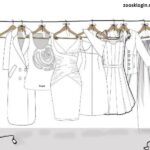Y2K fashion, short for “Year 2000,” refers to the distinctive style that emerged in the late 1990s and early 2000s, characterized by a mix of futuristic aesthetics, nostalgia, and an eclectic blend of influences from pop culture, technology, and youth subcultures. As we revisit this era, it’s essential to understand not just the clothing and accessories, but also the cultural context that shaped this unique fashion movement.
The Cultural Context of Y2K Fashion
Y2K fashion is deeply rooted in the socio-political and technological landscape of the late 1990s and early 2000s. The turn of the millennium was marked by significant technological advancements, the rise of the internet, and a burgeoning youth culture that thrived on digital communication. This period was also characterized by a palpable sense of anxiety surrounding the potential chaos of the Y2K bug, leading many to adopt a playful, almost rebellious approach to fashion.
The Rise of Technology and the Internet
The internet began to reshape society, influencing how people communicated, accessed information, and expressed themselves. Social media platforms were on the horizon, and digital culture started permeating everyday life. This technological boom influenced fashion trends, as young people embraced items that seemed modern and futuristic. Think of the shiny fabrics, metallic colors, and bold designs that dominated this era.
Pop Culture Influences
Y2K fashion was heavily influenced by pop culture. The rise of pop stars like Britney Spears and Christina Aguilera, alongside influential TV shows like “Friends” and “Sex and the City,” shaped the aesthetic preferences of the youth. Iconic looks from movies and music videos became the standard for many young people. For instance, the “low-rise jeans” and crop tops worn by celebrities were quickly adopted by the masses.
Youth Subcultures
Various youth subcultures also played a significant role in shaping Y2K fashion. From punk and goth influences to the skater and rave scenes, the blending of styles contributed to the era’s eclectic nature. Rave culture, in particular, introduced vibrant colors, baggy silhouettes, and playful accessories like glow sticks and bead bracelets, which became staples of the Y2K aesthetic.
Key Elements of Y2K Fashion
Y2K fashion is marked by several key elements that define its unique style. Understanding these components can help us appreciate the creativity and diversity of this era.
1. Bright Colors and Bold Patterns
One of the most striking features of Y2K fashion is the use of bright colors and bold patterns. Neon shades, pastels, and graphic prints were all the rage. This playful approach to color reflected the optimism of the new millennium, as well as a desire to stand out in an increasingly digital world.
2. Futuristic Fabrics
Futurism played a significant role in Y2K fashion. Shiny materials like metallics, holographic fabrics, and vinyl were popular, giving a sense of forward-thinking style. Designers experimented with textures and materials that seemed to embody the high-tech, digital future people envisioned.
3. Unique Silhouettes
The silhouettes of Y2K fashion were diverse and often unconventional. Low-rise jeans, cargo pants, and baggy shorts were common, paired with crop tops, halter necks, and oversized jackets. This contrast between fitted and loose silhouettes allowed for creativity and personal expression.
4. Accessories Galore
Accessories were a crucial component of Y2K style. Chunky platform shoes, butterfly clips, and colorful beaded jewelry became must-haves. Statement belts and bags featuring logos and bold prints were also prevalent, allowing individuals to showcase their personality.
5. Logo Mania
Branding was essential during this time, with many fashion labels opting for large, visible logos on their clothing. This trend was not just about the clothing but also about identity and belonging. Wearing a brand’s logo was a way for individuals to align themselves with a particular lifestyle or subculture.
Influential Y2K Fashion Icons
Several celebrities and influencers of the time played significant roles in popularizing Y2K fashion. Their distinctive styles left a lasting impact on trends, influencing countless fans.
Britney Spears
Britney Spears was one of the defining figures of Y2K fashion. From her iconic schoolgirl outfit in “…Baby One More Time” to the dazzling stage costumes, her style embodied the playful yet edgy essence of the era. Her influence can still be seen today, as fashionistas often draw inspiration from her looks.
Paris Hilton
Paris Hilton epitomized the glamorous side of Y2K fashion. Known for her love of pink and sparkles, she popularized the “bimbo” aesthetic, characterized by mini skirts, bedazzled tops, and designer handbags. Her impact extended beyond fashion, influencing the rise of reality TV and celebrity culture.
Avril Lavigne
Avril Lavigne represented the punk and skater influences within Y2K fashion. Her signature look featured baggy pants, graphic tees, and ties, combined with a rebellious attitude that resonated with many young people. Lavigne’s style was a stark contrast to the glitz of her contemporaries, showcasing the diversity of fashion during this era.
The Resurgence of Y2K Fashion
In recent years, Y2K fashion has made a significant comeback, driven largely by social media platforms like TikTok and Instagram. Nostalgia for the early 2000s, combined with a desire for self-expression, has led to a revival of many trends from this era.
Social Media Influence
Platforms like TikTok have allowed young people to explore and share vintage fashion trends, leading to a newfound appreciation for Y2K style. Viral challenges and hashtags related to Y2K fashion have created a sense of community, encouraging individuals to experiment with bold colors, unique silhouettes, and nostalgic accessories.
Sustainability and Vintage Shopping
The rise of sustainability in fashion has also contributed to the resurgence of Y2K aesthetics. Many young consumers are turning to thrift stores and vintage shops to find authentic pieces from the era, promoting a circular fashion economy. This shift not only aligns with environmental values but also provides a way to embrace individual style.
Modern Interpretations
Contemporary designers are reinterpreting Y2K aesthetics, incorporating elements of the style into their collections. Fashion weeks have seen a resurgence of bold patterns, metallic fabrics, and nostalgic silhouettes, reflecting the influence of the past on present-day trends.
Conclusion
Y2K fashion is a fascinating blend of nostalgia, innovation, and cultural reflection. As we look back on this era, we can appreciate the creativity and diversity that defined the style of the time. The influence of technology, pop culture, and youth subcultures all contributed to the unique fashion landscape of the early 2000s.
Today, the revival of Y2K fashion serves as a reminder of the cyclical nature of trends and the enduring power of self-expression through clothing. As we embrace this blast from the past, it’s essential to recognize the context in which these styles emerged and the impact they continue to have on modern fashion. Whether you’re a dedicated fan of the Y2K aesthetic or just beginning to explore it, there’s no denying that this era of fashion has left an indelible mark on our cultural landscape.






